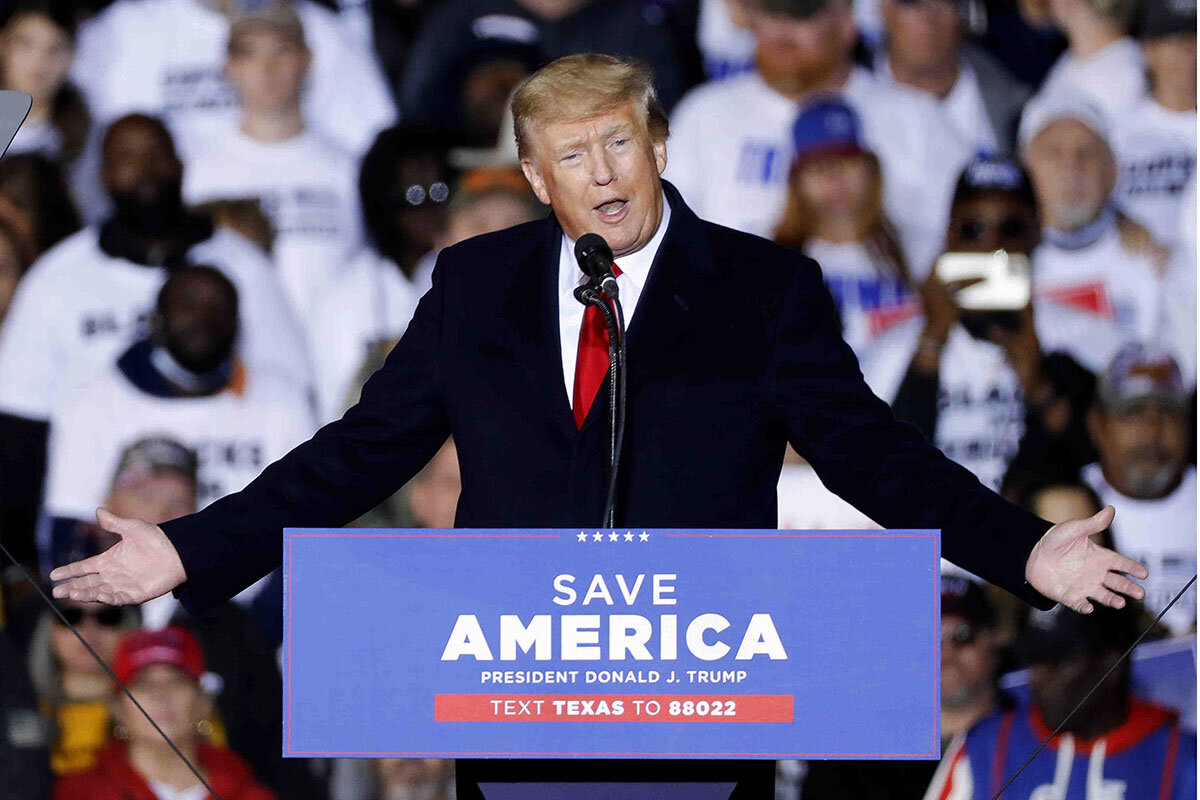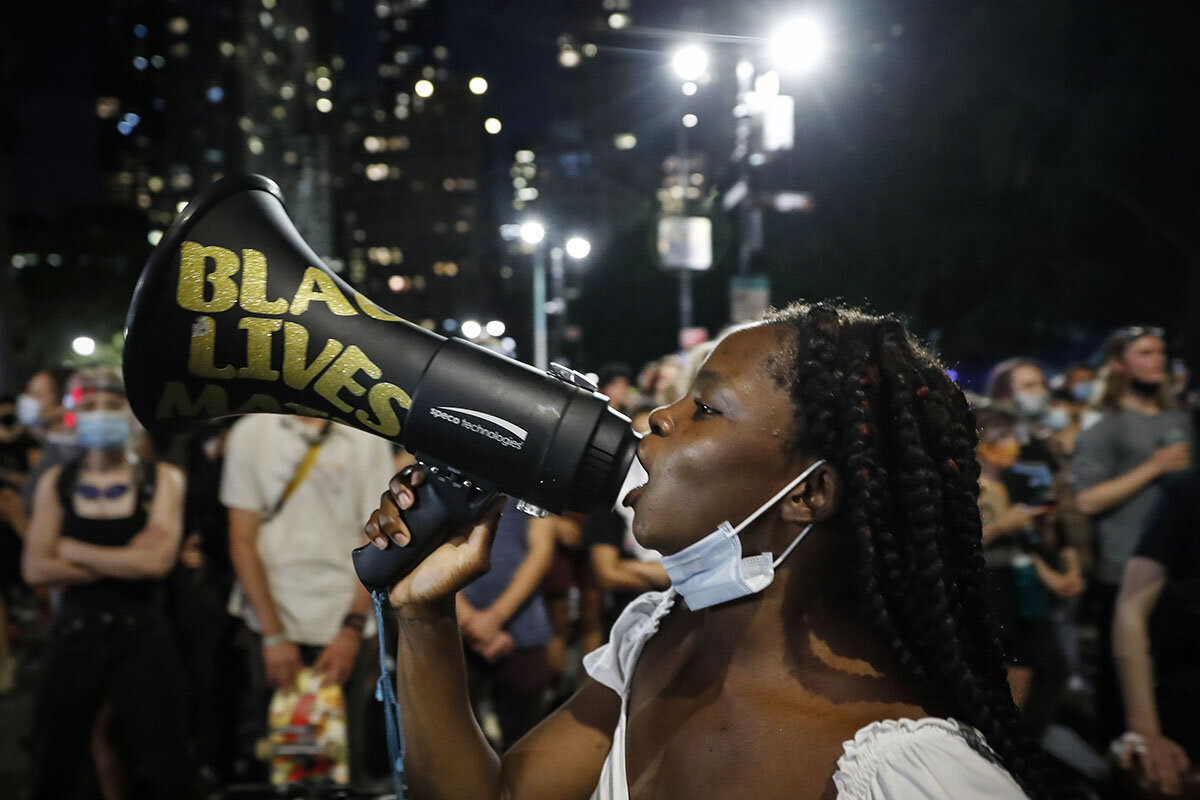Politics of pessimism: Why neither party is selling the American dream
Loading...
When J.D. Vance announced his run for Senate in his hometown of Middletown, Ohio, last July, he vowed to fight in Washington on behalf of Ohioans who “look to the future more with frustration and fear than with hope and optimism.”
A Marine turned venture capitalist, whose bestselling memoir, “Hillbilly Elegy,” detailed his scrappy Appalachian upbringing, Mr. Vance talked about an American dream that’s become out of reach for most. He spent much of the speech in the trenches of resentment, excoriating the elites who “have plundered this country.”
“They seem to want to take our love of country away from us,” he said.
Why We Wrote This
Even before the crisis in Europe and the COVID-19 pandemic upended a sense of stability, U.S. political rhetoric had taken a dark turn. It reflects a nation wrestling with a crisis in confidence amid fears of decline.
Such rhetoric has become standard fare in an era of partisan strife in which both sides seem drawn to prophecies of decline. The doom and gloom is framed differently by Democrats and Republicans, but they share certain touchstones, including a loss of faith in upward social mobility and a precarious vision of the future – particularly if the other side is in charge.
On the left, the racist sins of the past and stubborn persistence of structural inequities, coupled with worries of climate catastrophe to come, cast a dark shadow. On the right, rapid demographic and cultural change and the waning influence of Judeo-Christian values has led to a lost “American” identity. Both sides say the economic deck is stacked against average citizens; both look out onto a world in which the U.S. is no longer as respected or feared.
The COVID-19 pandemic and now the security crisis unfolding in Europe have only further dampened the mood. As President Joe Biden prepares to address the nation in tonight’s State of the Union, it’s hard to imagine him making the case, as former President Barack Obama did in a 2016 Howard University commencement address, that the best time in human history to be born – regardless of race, gender, nationality, or sexual orientation – is now.
Politics is cyclical, and America has certainly been through dark periods before – from the Great Depression to the “malaise” of the 1970s to the financial crisis of 2008. Still, what sets this era apart is how few political leaders are proffering optimism as a way through it. Where previous eras were often buoyed by an underlying faith in America’s goodness and the promise of a brighter future, today that national confidence seems seriously shaken.
Rhetoric of previous presidents – from Franklin D. Roosevelt to Ronald Reagan to Barack Obama – featured different ideological beliefs, “but the narrative components [were] pretty similar,” says Robert Rowland, a professor of communications at the University of Kansas. “In the great arc of American history, the positive emotions have always ruled. And narratives about the American dream have been crucial.”
Longing for the past
That seemed to change, Professor Rowland says, with Donald Trump’s presidency. President Trump’s vision of the future stood out for being in many ways a revival of a golden past, invoked in his campaign slogan “Make America Great Again.” He connected with the GOP base not by declaring “Morning in America,” as President Reagan famously did in 1984, but by voicing visceral anger at the “American carnage” all around.
“Negative emotions are at the core of his message,” says Professor Rowland, author of “The Rhetoric of Donald Trump: Nationalist Populism and American Democracy.”
Notably, President Biden’s pitch during the 2020 campaign also seemed to rely implicitly on a vision of the past, as he promised voters he would restore the country to a kind of pre-Trump normalcy.
Messages of doom and anxiety about the future have become a turnout strategy for both parties, who now routinely tell their voters that America itself could end if the other side wins the next election. For Democrats, it’s democracy that’s at stake; for Republicans, it’s freedom.
Negative partisanship – where voters are more motivated by fear of the opposing party than love of their own – has replaced appeals to common values and goals, says Frank Luntz, a veteran Republican strategist.
“There was a time when Americans saw the best in people. Now, it’s only the worst,” Mr. Luntz says via email.
Making electoral contests so existential actually distracts from tackling long-term challenges, notes Yuval Levin, director of social, cultural, and constitutional studies at the right-leaning American Enterprise Institute. “We’re stuck in this, ‘are we going to make it through the next few years?’” way of thinking, he says. “We exaggerate the dangers we face, almost as a way of avoiding talking about the future.”
This myopia mirrors the horizon of many leaders in Washington who are in their 70s and 80s, a boomer generation that still holds power. It may also reflect a nation whose overall population is aging – with seniors on track to outnumber children for the first time ever sometime in the next decade, and young people, also for the first time, expected to earn less than their parents. Given these trend lines, any promises that the country’s best days lie ahead might well ring hollow.
“The country feels itself to be elderly in a way that’s unusual for the United States,” says Mr. Levin. “We have a sense that there was a moment when the future happened here, and America was everything – and that moment has passed.”
A glass half empty
To be sure, the past two years of the COVID-19 pandemic, and now Russia’s invasion of Ukraine, have created a sense of instability and fogged up the future. Still, the politics of pessimism, of a glass half empty and springing a leak, were present even before the current crises.
A Pew survey in 2018 found that many Americans saw their country as one in which economic inequality, national indebtedness, and political dysfunction were likely to increase by 2050. Half of respondents said children born today would have a worse standard of living in 2050; only 1 in 5 believed the average family would be better off in the future.
Nor did they see a superpower standing tall. Six in 10 said the U.S. would be less important in the world in 2050, compared with 31% who said it would be more important.
To many on the right, that sense of an unraveling global order has been mirrored by a breakdown of political hierarchies and a cohesive identity at home.
The 2020 census confirmed what experts have long predicted: The U.S. is on track to become sometime in the next few decades a country in which whites will be a minority. This is already true for under-18s, where no racial or ethnic group has a majority. The census revealed a white population in absolute decline due to deaths and low birth rates, though a rise in people identifying as mixed-race was also a factor. Between 2010 and 2020, the share of the white population fell from 64% to 58%, a historic low.
“We’re not at a moment of stasis in this country. We’re at a moment of religious and demographic change,” says Robert Jones, founder and CEO of the Public Religion Research Institute.
This upheaval has been unsettling for some white Christians in the Republican coalition who believe that America has a divinely ordained role and are wary of a multiracial, multifaith future, says Mr. Jones. “They’ve been accustomed to think of America as their country.”
In a 2021 poll by PRRI, 7 in 10 Republicans agreed that American culture and its way of life were worse now than in the 1950s. By contrast, 63% of Democrats said it had changed for the better. Similarly, 8 in 10 Republicans said America was in danger of “losing its culture and identity,” compared with 33% of Democrats. (White evangelical voters, a mainstay of the GOP base, expressed identical views.) Republicans are five times more likely than Democrats to say racial, religious, and ethnic diversity makes the U.S. weaker, not stronger, the poll found.
“Democrats are leaning into the demographic future of the country, and Republicans are trying to hold on to a 1950s view and composition of America,” says Mr. Jones, author of “The End of White Christian America,” published in 2017.
But the left’s embrace of demographic change has often been tempered by a different brand of backward-looking pessimism.
Some Democrats look back to the 1950s as an era of economic fairness and less income inequality, in which unionized workers could afford the kind of middle-class lifestyle that seems out of reach for so many today. Many also use the past as a yardstick for progress on racial and social justice – and find the U.S. still coming up woefully short.
The promise of Mr. Obama’s presidency, and his emphasis on a slow but inexorable path to a better future for all, has given way to frustration over systemic racism that exploded on the streets in 2020 after the murder of George Floyd.
The left’s focus on America’s roots in slavery and racism in institutions has compounded the sense of a nation that, far from being providential, seems mired in sin. “They think it’s totally unredeemable,” says Rich Lowry, editor-in-chief of the conservative National Review and a critic of what he calls the illiberal left.
In the PRRI poll, 54% of Democrats said that at some point in their lives they had not felt proud to be American. When the question was asked in 2013, most Democrats could not recall a time when they had felt this way. (One in 4 Republicans said they had not always felt proud.)
Mr. Lowry says the left’s despair over the lack of racial justice and historical wrongs is at odds with a record of unmistakable progress. “America has never been more open and pluralist and non-racist. It’s never been as close to realizing its ideals of justice and equal treatment under the law,” he says.
Still, Jonathan Rauch, a senior fellow in governance studies at the Brookings Institution, argues that the pessimism on the left tends to be more “future-oriented” than on the right because it’s not tethered to a golden past. This creates at least some space for political hope, even as anger over issues like racial inequality and policing dominate the discourse, along with frustration over inaction on climate change.
“They’re disappointed we’re not at the promised land yet, but they still see one there,” he says.
Immigration and the American dream
Some conservatives push back on the idea that fear of demographic change is driving negative polarization on the right. Mr. Lowry blames the “woke ideology” of elite institutions that have marginalized conservative voices and made them feel embattled and shunned even when they win elections.
He says this has fed a politics of resentment, particularly as practiced by Mr. Trump, whose occasional forays into optimism often drew mockery from the media for being out of touch with reality – from his predictions that COVID-19 would vanish to his claims he had cut a nuclear deal with North Korea’s Kim Jong Un.
Mr. Lowry recently reread President Reagan’s speech at the Republican convention in 1980, a time of intense national gloom over inflation, oil prices, and Iran. Mr. Reagan spoke to all these issues, but still sounded remarkably upbeat about the future. “You shouldn’t be optimistic in all circumstances,” Mr. Lowry says. “But I still think most people in this country want you to be future-oriented.”
In Mr. Reagan’s era, that vision of a brighter future included immigrant-led population growth. In his final speech as president, he called for America’s doors to remain open “to anyone with the will and the heart to get here.” That positive view of immigration had long eroded among conservatives by the time Mr. Trump took office vowing to build a border wall. Since then, legal immigration to the U.S. has declined, and fell sharply during the pandemic.
Notably, immigrants skew younger, have larger families, and put more stock in the American dream than U.S.-born citizens, particularly for their children. “The most optimistic Americans are the new Americans,” says Professor Rowland.
Young people should likewise be optimists, says John Della Volpe, director of polling at the Institute of Politics at Harvard Kennedy School and author of a book on Generation Z. The generation now coming of age – the oldest of whom are in their mid-20s – have never seen the country really “pull [together] in the same direction,” such as after the 9/11 terrorist attacks.
Analysts say President Biden lacks the rhetorical skills of Mr. Obama, under whom he served as vice president. Still, Mr. Della Volpe points to a “pitch perfect” speech he gave in June 2020 after Mr. Floyd’s murder, when he spoke of how progress can come from the darkest moments.
Leaders need to give young Americans a reason to believe in the democratic process, Mr. Della Volpe says.
They also need to make a conscious effort to message optimism to voters – even when times are hard and it seems easier to rile up the base with anger, adds Mr. Rauch. Otherwise, he warns, the sense of hope and promise that’s long been a key cornerstone of the American story could be lost.
“There’s a risk that this kind of talk drops out of the vocabulary when politicians fall out of practice,” he says. “They forget how to play these chords.”










